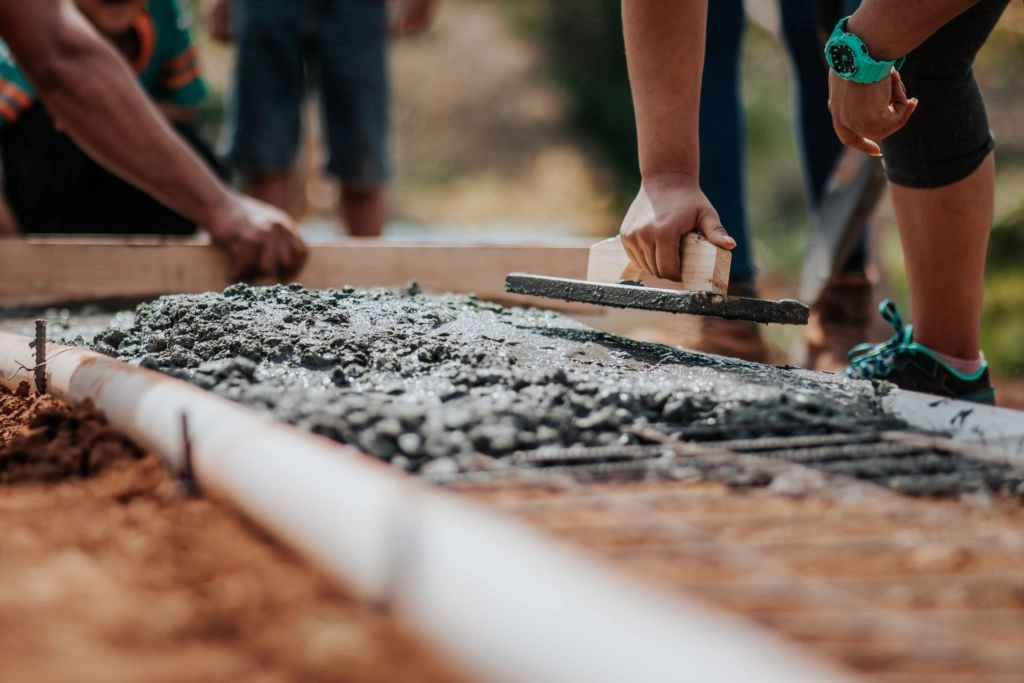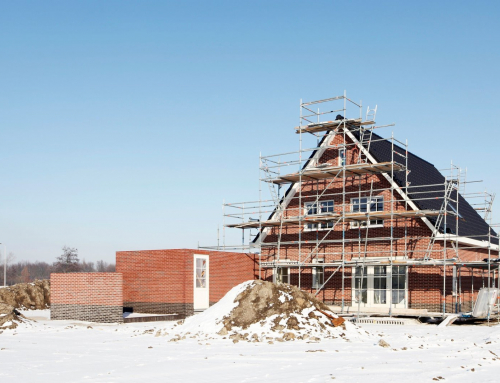When people think about landscaping, they often picture gardens, pools, elaborate fountains, gondolas, and grass, but one of the most important landscaping features is the solid ground that acts as the foundation of the outdoor space of a home: the hardscape. This brings to mind the question, what is better for your hardscape? Stamped concrete vs pavers?
Walkways, sidewalks, and driveways are essential to a functional, aesthetically pleasing, and complete home. They lead to the entrance of your house and can help make your property stand out.
They can also be one of the priciest landscaping endeavours you’ll encounter. Likewise, the installation of hardscapes is probably one of the most permanent decision you’ll make around your outdoor space. Hardscaping is an investment for the home and while often expensive, prices vary based on the material (but more on that later). Concrete and asphalt are the most popular choices for most of the population, however, if you want to make your outdoor space pop, you should consider stamped concrete vs pavers.
Stamped concrete is concrete that has had patterns and/or textures set into it. These patterns can resemble bricks, stones, wood, and many other looks. Stamped concrete can be coloured to your desire or molded to match a different building material. It is more economical than the building materials it is often made to resemble such as brick stone.
Concrete pavers, or paving stones, resemble and act like tiles, except they belong outdoors. They can come in a variety of shapes, sizes, patterns, and colours.
Whether you decide to lay concrete or go the paver route, adjusting the ground around your home is not a Do-It-Yourself friendly project and should be done in partnership with a trusted landscaper. Hyland Landscapes, which services the Greater Vancouver Area and beyond, offers a variety of paving options to settle your heart’s desire for a new walkway or driveway and can help you determine what is better, stamped concrete vs pavers.
Let’s take a look at some of the attributes of each:
Appearance
Stamped concrete
Is often described as having an ornate quality and can really elevate the look of a pathway with its elegant and subdued impressions. It’s a chameleon material that can imitate the look of other natural materials like brick, or slate, elevating the general aesthetic of the property without costing a fortune.
Pavers
On the other hand, are available in many variations. A skilled landscape designer could craft truly unique and eye-catching designs for the home by mixing and matching pavers. The design flexibility is very appealing to those who want to create a strikingly beautiful property.

Installation
Stamped concrete
The installation of stamped concrete involves several steps, starting with subgrade preparation, which refers to the base on which the concrete will be placed. The subgrade should be well-compacted to ensure the structural integrity of the slab being placed in the space. Keeping the subgrade well-compacted will help deter drainage and can prevent soil erosion beneath the layer of concrete. Once the subgrade preparation is complete, the forms are placed in the desired space. Forms are usually made of wood, metal, or plastic, and are fixed to stakes to contain the concrete pours in the places they should be. Forms should be in excellent condition to ensure they can aid in drainage. After this, steel bars or welded wire mesh are used to reinforce the structure. These reinforcements also help to control cracking in the concrete.
After all of this, the concrete is finally poured into the designated area from a truck with a chute. Plastic sheeting is placed down around the area to protect other structures. Once the concrete is poured in, workers have to move fast to create the canvas that they are about to stamp. Before the act of stamping, the surface of the concrete is leveled so that it’s not sloping too high or low on either end. At this point, if the concrete is to be coloured, the colour is applied through dry-shake colour hardeners, stains, or powdered or liquid release agents.
After preparing the canvas, there is a short period of time to do the actual stamping before the concrete starts to dry. This is especially fast if you’re placing concrete in the summer when it dries faster. The concrete is stamped based on the agreed layout, in the same order that the concrete was placed.
Once the stamping process is complete, concrete is left to dry or “cure”. To cure concrete, it is best to retain a good level of moisture content for the required properties of concrete to develop. Contraction joints can also be added at this stage to prevent cracking. And then finally, the stamped concrete is sealed, adding richness to the colour of the concrete, a bit of sheen, creating a protective layer from the wear and tear of daily use.
Despite the long process of installing stamped concrete, it is thought of as the easier method, as pavers are installed by hand. The longest part of installing stamped concrete is leaving time for it to set and dry.
Pavers
When installing pavers, each “tile” must be laid one by one. Pre-planning is absolutely crucial here. First, it’s necessary to plan the area in which the pavers will go and then it’s necessary to create an outline in spray paint or chalk. The next step is to calculate the number of pavers needed by measuring the width and length of the area being paved. If you know that certain pavers will need to be cut to fit curved edges, your landscaper will likely suggest that you need to purchase an additional 5-10% of the material to make that possible.
After the measuring, it’s time to excavate the area where you’re placing the pavers. If paving in front of your home, the slab should slope downward and away from the house to allow water drainage. Then it’s time to dig, excavation includes digging out the ground to the desired depth. To complete the process, the ground is leveled and compacted, often by a compacting machine.
Once the excavation is complete, the next step is to lay the base material in the desired space. Typically, the base material is composed of crushed rock, or gravel with a little bit of moisture in it. Moisture is helpful in controlling how compact the base layer is. If you’re placing pavers in a driveway, a thicker base layer will be needed due to the weight of the vehicles driving over it. The base layer is then also leveled, sloped, and graded to the desired height. Following this, edge restraints need to be installed to ensure that the pavers don’t move. These are usually made of concrete, metal, wood, or plastic
The next step is to create a layer of bedding sand over the base layers to help further compact the base material. This is the bed on which the pavers are set. The pavers are placed in accordance with the agreed-upon design plan.
But the job isn’t done there. Next, sand is swept over the surface to fill up the joints and lock the pavers into place. This must be done while it’s dry outside. Following this, there is the cleaning and sweeping of the pavers. Finally, the area needs to be sealed to ensure the joint sand doesn’t disappear. The joint sand prevents the growth of vegetation between the joints and protects the pavers from dirt, tire markings, and general wear and tear.
Both stamped concrete and pavers have a complex process of installation. Regardless, a landscaping company should be involved in the creation of your updated outdoor landscape.
Durability
Both concrete pavers and stamped concrete hardscapes are generally durable long-term if well maintained.
Stamped concrete
It is more likely to crack or split, especially in areas that are open to natural weather occurrences like earthquakes or tremors. Massive temperature shifts can also cause concrete to split or crack.
Pavers
Typically don’t crack but they do loosen over time, and with wear and tear. However, the loose pavers can be replaced.
In terms of durability, pavers are easier to deal with as you can replace individual tiles. Concrete, on the other hand, can last for many years but if your stamped concrete pieces are large, they must be replaced in full if a crack needs to be fixed.
Maintenance and Repairs
Stamped Concrete
It is generally easier to maintain but as previously mentioned, it can crack and stain with time. Generally, stamped concrete can be rinsed off and washed with dish soap, and sealants can be added to block stains but these need to be reapplied regularly to protect the area.
Pavers
Can be easy to clean but not as easy as stamped concrete, which is often a larger slab. An eye should be kept on the cracks between the pavers to ensure that weeds aren’t making their way through spaces between. Repairs should be fairly quick with pavers because you can remove individual pieces.
A Summary of the Pros and Cons for stamped concrete
This is one of the most commercial options for hardscaping. Stamped concrete comes in a variety of colours and patterns. The stamped look is achieved by stamping the concrete while it’s still wet.
A comprehensive list of pros and cons for stamped concrete:
Pros:
- Stamped concrete has an ornate look and can really make an outdoor space dazzle
- It is available in a wide variety of colours, patterns, and textures
- It can imitate stone or brick look at a much more affordable price
- Stamped patterns can be customized, allowing for innovative design
- Concrete can be sealed for added protection against the weather and chemicals
Cons:
- Prone to cracking. Some consumers actually enjoy this look but prolonged cracking can damage elements that come in contact with the concrete
- Stamped concrete should NOT be driven on
- It is prone to absorbing moisture
- The cost of repairs can be expensive if you live in an irregular climate
- Repairs often mean replacing large sections of concrete. Smaller repairs can be patched but it can be difficult to match colours as the previous concrete colours surrounding the area will have faded over time
- The colours fade with age
- It needs to be re-sealed every year
- It is slippery when wet
A SUMMARY OF THE PROS AND CONS FOR Pavers:
They are considered to be an elegant hardscaping material. They can withstand tough weather and heavier weight than stamped concrete. There are hundreds of styles available.
A comprehensive list of pros and cons for pavers:
Pros:
- Pavers are more durable, thicker, and will not crack
- In case of damage, individual tiles can be replaced, rather than having to remove large chunks of the hardscape
- Paver tile patterns and colours can be combined to create interesting patterns and a unique look for the space
- They are stronger than concrete, pavers can be driven on
- They are resistant to moisture
- They are not slippery when wet
Cons:
- The joint sand that’s placed between the pavers needs to be topped off every year or two to prevent vegetation growth
- Pavers are more prone to movement. If there are spots in which the base material isn’t compact enough, pavers can move
- There is a more limited selection of patterns and colours available
Wrapping it up
Both stamped concrete and pavers are great options if you’re looking to revamp the hardscapes on your property. The cost will vary based on the size and scope of the work. In some cases, it might work well to combine both stamped concrete and pavers in your front or back yard. For example, if you’re redoing your entire landscape, pavers are the best option for a driveway if you are looking to add a touch of luxury to the entrance of your home. Alternatively, stamped concrete would work well on pathways designed for foot traffic as they cannot handle the weight of an automobile. If redoing an area near a pool, pavers might be a better option because they’re less likely to be slippery when wet. The combinations are endless.
For the Vancouver area and beyond, the experts at Hyland Landscapes are available to help you plan and create the hardscapes you’ve always wanted for your property. We’re also happy to help answer your questions regarding stamped concrete vs pavers!




